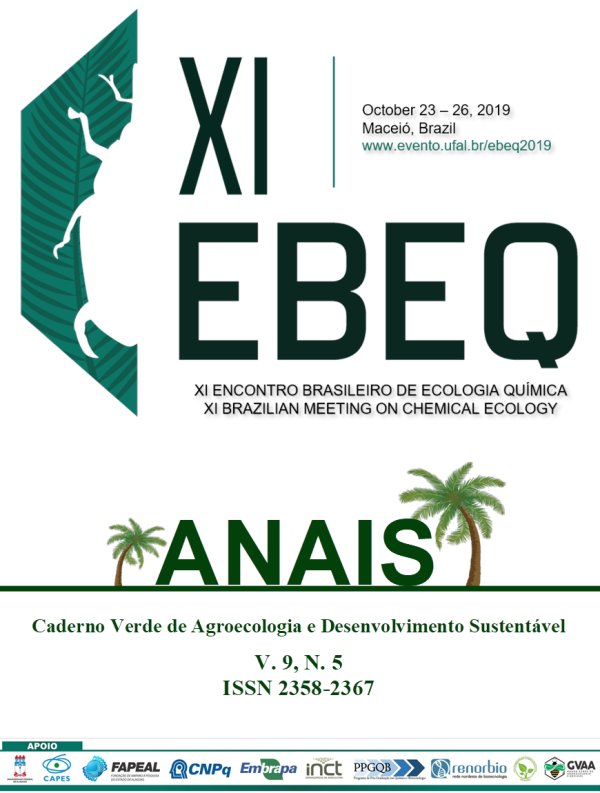IDENTIFICATION OF VOLATILES ORGANIC COMPOUNDS IN SOYBEAN FLOWERS BY HS-SPME-GC-MS
Palabras clave:
VOLATILE COMPOUNDS, SOYBEAN, POLLINATORS, GAS CHROMATOGRAPHYResumen
Flowers release a variety of volatile organic compounds (VOCs) to attract pollinators. In soybean fields, bees are commonly observed foraging during the flowering, possibly attracted by visual and/or olfactory stimuli. Thus, the aim of this study was to identify the compounds produced by soybean cultivars with flowers with white and purple petals. The plants were grown in a greenhouse and the flowers collected and packed in headspace (HS) vials. For VOCs capture, the divinylbenzene/carboxene/polydimethylsiloxane SPME-fiber (DVB/CAR/PDMS) was used, and the analyses were performed on the gas chromatograph coupled to the mass spectrometer (GC-MS). In purple petal from the cultivars ‘BRS 399RR’, ‘BRS 1001IPRO’ and ‘Monsoy 6410IPRO’, 21, 39 and 35 COVs were detected, respectively. In white petals, 26 compounds were observed in ‘BRS 388 RR’, 24 in ‘DonMario 6563IPRO’ and 21 in ‘TMG 7063IPRO’. Chemometric analyses were performed and, based on PCA, PLS-DA and VIP, in all cultivars 2-hexenal; 1-hexanol; hexanal; 1-octen-3-ol; 1-hepten-3-one and furan, 2 -pentyl were detected. Multivariate statistical data showed that only 1-octen-3-ol was the compound with the highest intensity in relation to the other metabolites identified in soybean flowers. 1-hepten-one was the second compound with the largest chromatographic area, in purple petal cultivars, and 2-pentylfuran in white petal cultivars.1-Octen-3-ol was previously described in the literature as possessing stimulatory activity to Apis mellifera ligustica. Therefore, future studies of pollinator behaviour using the electroantennogram should be performed to understand the relationship of attractiveness and/or repellence to bees in response to VOCs released by soybean flowers.Descargas
Publicado
Cómo citar
Número
Sección
Licencia
Termo de cessão de direitos autorias
Esta é uma revista de acesso livre, em que, utiliza o termo de cessão seguindo a lei nº 9.610/1998, que altera, atualiza e consolida a legislação sobre direitos autorais no Brasil.
O(s) autor(es) doravante designado(s) CEDENTE, por meio desta, publica a OBRA no Caderno Verde de Agroecologia e Desenvolvimento Sustentável, representada pelo Grupo Verde de Agroecologia e Abelhas (GVAA), estabelecida na Rua Vicente Alves da Silva, 101, Bairro Petrópolis, Cidade de Pombal, Paraíba, Brasil. Caixa Postal 54 CEP 58840-000 doravante designada CESSIONÁRIA, nas condições descritas a seguir:
O CEDENTE declara que é (são) autor(es) e titular(es) da propriedade dos direitos autorais da OBRA submetida.
O CEDENTE declara que a OBRA não infringe direitos autorais e/ou outros direitos de propriedade de terceiros, que a divulgação de imagens (caso as mesmas existam) foi autorizada e que assume integral responsabilidade moral e/ou patrimonial, pelo seu conteúdo, perante terceiros.
O CEDENTE mantêm os direitos autorais e concedem à revista o direito de divulgação da OBRA, com o trabalho simultaneamente licenciado sob a Licença Creative Commons do tipo atribuição CC-BY.
O CEDENTE têm autorização para distribuição não-exclusiva da versão do trabalho publicada nesta revista.
O CEDENTE têm permissão e são estimulados a publicar e distribuir seu trabalho online (ex.: em repositórios institucionais ou na sua página pessoal) a qualquer ponto antes ou durante o processo editorial, já que isso pode gerar alterações produtivas, bem como aumentar o impacto e a citação do trabalho publicado.








